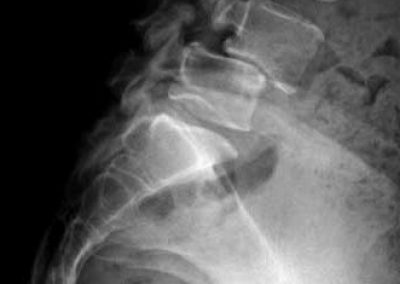Spondylolisthesis
Definition of the Spondylolisthesis
Cause: Malformation or degeneration
Spondylsisthesis can be caused by an inherent malformation or age-related degeneration of the spine.
Seldom, stress fractures in active athletes (e.g. rowing, gymnastics) or acute fractures can also cause a slipped vertebra.
Symptoms
Common symptoms are acute back pain (lumbago) and, at a later stage, leg pain upon walking (claudication), similar to the symptoms of spinalstenosis.
Treatment
Less severe can be treated conservatively, i.e. chiropractic treatment, physical therapy or epidural injections.
Failure of conservative therapy or more severe symptoms may require surgery.
Surgical treatment decompresses the spinal canal and reduces the slipped vertebra by a fusion of the involved spinal segments. (Spondylodesis)
Failure of conservative therapy or more severe symptoms may require surgery.
Surgical treatment decompresses the spinal canal and reduces the slipped vertebra by a fusion of the involved spinal segments. (Spondylodesis)
Post-surgical course
Patients stay hospitalized approximately one week. Rehabilitation exercise can be started the day after surgery.
Results
Surgical treatment achieves good to very good results. Patients suffer from considerably less back and leg pain. Quality of life is remarkably enhanced by the fact that walking pain will be absent.
On seldom occations, hematoma formations or impaired wound healing may require revision surgery.
Complications, such as paralysis or infections, are rare.
There is a chance that spinal stenosis may reappear years later.
On seldom occations, hematoma formations or impaired wound healing may require revision surgery.
Complications, such as paralysis or infections, are rare.
There is a chance that spinal stenosis may reappear years later.

